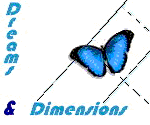Don from New Zealand got
his Condor finished and in service
You might remember him or better his design the
"Hovershuttle" - his Condor is more or less in the same lines with just
a bit more power and comfort.

A few details about his craft :
Length = 6 meters
Width = 3 meters
seating for 11 including pilot.
All Fiber Glass and foam construction with Alloy
hard points glassed in.
Craft weighs in at 2 ton, power plant is a
Toyota twin turbo V8 of 300 hp driving hydraulics.
Lift unit : 2 dual centrifugal fan 400 mm dia.
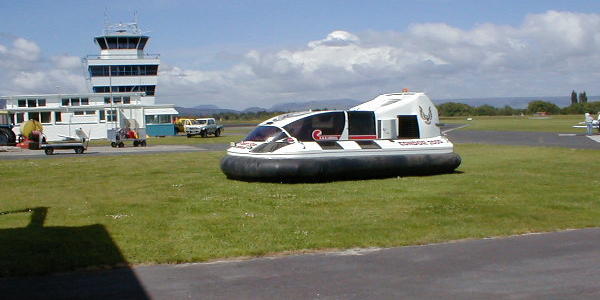
If you would like to know more, contact Don direct
at, rdsainty@wave.co.nz
|
The Alpha-II
In the last 17 month we were extremely busy finishing the Alpha-II
prototype craft.
The Alpha-II is a module Hovercraft with a variable custom build cabin
section for either 4 passenger (22' length ) 6 passenger ( 25' length )
or 8 passenger with 27' length over all ( all + 1 pilot crew). The
lift ( bow ) unit as well as thrust ( stern ) unit are fix components for
all three models of the Alpha-II series. This allows a big amount of flexibility
in the passenger / payload area while a proven performance in the whole
design series with relative short set up cost per model.

If you like what you see feel free to visit the shop : http://www.4wings.com/crafts/a2con/a2con.html
All 3 models of the Alpha II use a flight control system
intended to provide a more natural driving experience for the operator.
From an electronic control aspect, it consists of a centralized feedback
and control unit connected to feedback sensors (lateral acceleration, airspeed,
and steering wheel position) working in conjunction with a single on board
microcontroller. Unique control surfaces operate in both the thrust and
speed generated air stream domains.
A touch screen in the pilots area provide manual input and adjustment
As with any advanced system the Alpha II flight control development
will undergo a period of experimentation to characterize the effectiveness
of the control surfaces at different flight regimes. Once the overall system
has been optimized for general operator "feel" and comfort, a further analyses
will be performed to determine the amount of required system redundancy.
In other words, some experimentation is required to determine if the added
comfort level provided by the unique control system extends into a safety
critical area that requires double or triple system redundancy.
This will keep us a bit busy for the next month while input from commercial
builders is highly welcome at : michael@4wings.com
.
|
Not really a Hovercraft - but it hovers extremely
powerful -
F-35 The Flexible flyer
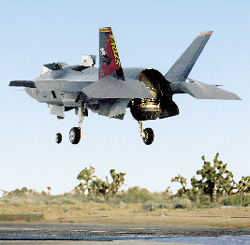 The F-35s are a family of three aircraft, designated
the F-35A, F-35B and F-35C. Similar in shape and size, and powered by the
same basic engine, the F-35s will share between 70 and 90 percent of their
parts. Yet, under the skin they are three distinctly different machines.
The F-35s are a family of three aircraft, designated
the F-35A, F-35B and F-35C. Similar in shape and size, and powered by the
same basic engine, the F-35s will share between 70 and 90 percent of their
parts. Yet, under the skin they are three distinctly different machines.
The three versions of the F-35 are: a conventional
takeoff version for the Air Force, a larger wing, long range Navy plane,
and an extra lift, vertical flyer for the Marines and UK. "The [F-35A]
would allow for migration by U.S. forces to an almost all-stealth fighter
force by 2025," says Edward Aldridge, undersecretary of Defense for Acquisitions.
U.S. Marines will fly the F-35B, which is detailed
in the cutaway
drawing
The Marines will use the F-35B to retire their
current and rapidly dwindling fleet of British designed AV-8B Harrier jump
jets. F-35Bs would be deployed with Marine Expeditionary Units and operate
off short runway landing ships.
The Navy will fly the most visibly different
member of the JSF family, the F-35C.
Power lifting.
The biggest denominator and challenge was short
takeoff/vertical landing (STOVL) propulsion, propulsive lift, engine, and
flight controls have to all run smoothly together.
The F-35 makes its most radical departure from
the past with the choice of the lifting system for the F-35B jump jet.
Team engineers decided to go with a more efficient and seemingly more complex
system a power takeoff (PTO) shaft from the propulsion engine's fan drives
a lift fan packed into the front of the airplane (see figure). The fan
works in conjunction with a downward swiveling rear engine nozzle that
can twist 90° thanks to triple bearings around the nozzle's circumference.
Lifting with cooler air offers several advantages. Chief among them are
less heat stress on the engine and a smaller infrared signature for anti-aircraft
missiles to home in on. The tradeoff is a higher degree of mechanical sophistication.
There are three parts to the lifting system.
The first part is the lift fan. About half of the thrust needed to hover
and land is created by forcing ambient air downward through a pair of doors
that open directly behind the cockpit. Power comes from a 2 stage low-pressure
turbine on the engine and is coupled to the lift fan through a clutch.
The fan itself consists of a pair of counter rotating turbines that are
capable of creating as much as 18,000 pounds of thrust. Roughly the same
amount of thrust is created by blasting hot gases from the engine downward,
through a 3 bearing nozzle, the system's second part. For roll control
in hover, there is a nozzle under each wing fed directly by engine air.
The complete system produces about 40,000 lb. of lift.
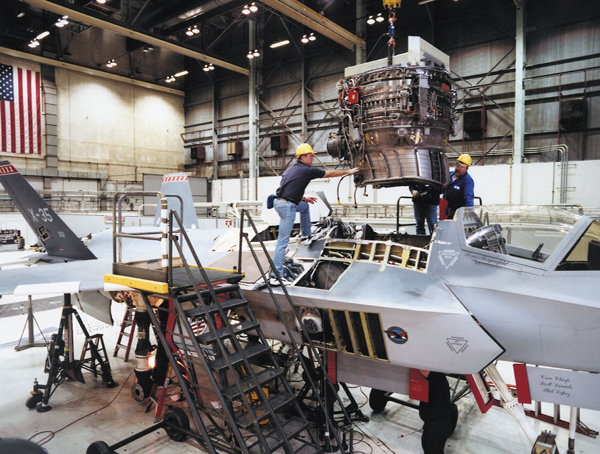
Production
The three versions share more than 80% identical
parts. Cousin parts can be made from the same blanks and handled and assembled
with common tools and fixtures. For example, bulkheads for each version
differ only in thickness.
Electrons for muscle and nerves
While aerodynamics shape the F-35, electronics
allow it to function. Here are some of the significant systems on board:
Electrohydrostatic actuators from Moog (East
Aurora, NY) and Parker Hannifin Aerospace (Irvine, CA) eliminate centrally
supplied hydraulics, saving weight. Electricity is used to power small
hydraulic units throughout the airplane for control surface actuation.
Engine-mounted power thermal management system
by Honeywell (Torrance, CA) furnishes electricity for starting the engine,
drives the environmental control system, acts as an in-flight electrical
generator, and with its battery, functions as an emergency power source.
Such multiduty systems save weight. Radar is electronically scanned and
reprogrammable for air-to-air and air-to-ground combat. Twin rear projection
displays (MEMS based) in the cockpit fuse sensor and aircraft outputs to
present information, not data, to the pilot. Projection technology is used
since flat-panel developments are too short lived for the long-term product
support needed in military use. The pilot can control systems using the
display touch screen, switches on the throttle and control stick handles,
or voice activation. The head up display (HUD) is gone. A helmet mounted
display will give the pilot information while looking in any direction.
Electro-optic and infrared systems driving this display will allow the
pilot to see all around, even through the bottom of the airplane.
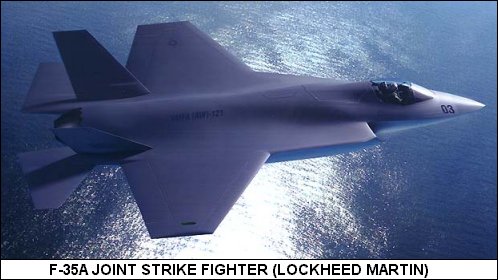
|
Hovercraft could have rescued
girl
THE grandfather of tragic schoolgirl Lelaina Hall is urging Worcester
residents to back a life-saving appeal. Terry Page says their help is urgently
needed to pay for a hovercraft, which will be named after the five-year-old
to keep her memory alive.
The Western Daily Press has launched a campaign to fund the vessel,
which could have saved her life. Thousands of pounds have already poured
in.
"A lot of people in Worcester knew Lelaina but they don't know how
to make a donation."
The Western Daily Press has joined forces with the Association of Search
and Rescue Hovercraft to raise £35,000 needed to buy and equip a
BBV6 hovercraft.
It would be based at Bridgwater Bay, close to Berrow Beach where Lelaina
died on Sunday, June 23. She had become trapped in mud flats after
running on to the beach on the final day of a family seaside holiday.
"The hovercraft would have got to her in five minutes," said Mr Page.
"Instead, it took an hour. None of us are coping very well. "
"The hovercraft will be called Lelaina in her memory. At least something
good will have come out of her death. "They are dangerous beaches and it's
made me more aware of the dangers."
The fund currently stands at £9,000. "It's going very well,"
said Ellie Campbell, news editor at the Western Daily Press, in Bristol.
"People obviously feel very strongly about it to give this much in
one week." To make a donation to the fund call 0117 934 3434 or send a
check to The Lelaina Hovercraft Fund, Western Daily Press, Temple Way,
Bristol BS99 7HD. Checks should be made payable to the Association of Search
and Rescue Hovercraft.
Hover rescue
Hovercraft have traditionally been used as passenger vehicles, although
the cross-channel service from England to France stopped flying in 2000.
Now the Royal National Lifeboat Institution is putting a new, smaller hovercraft
on trial as a search and rescue vessel. The hovercraft the RNLI is using
carries a crew of four people and could be ideal for rescuing people. Its
speed and ability to travel on land as well as water make it the perfect
vehicle for rescuing people who are stranded in quicksand, mud or thin
ice .
The RNLI wants to find out whether the hovercraft is suitable for search
and rescue and see how easily crews used to boats can learn to operate
it. In a test, the hovercraft picked up two people who were stranded 100
meters out on the sands in under two minutes. Meanwhile, the coast guard
took 20 minutes to reach a colleague stuck in mud just 50 meters away.
Perhaps these test will encourage other SAR units to take a closer look
at the abilities of Hovercraft for search and rescue purpose.
|
